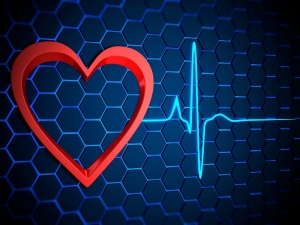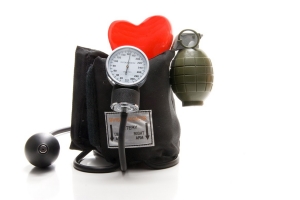Learn About Hypertension
Hypertension (high blood pressure) is a disease. You can have hypertension for years without any symptoms; all the while it can be causing damage to your blood vessels and your heart.

What is High Blood Pressure (Hypertension)?
High blood pressure is a common condition in which the long-term force of the blood against your artery walls is high enough that it may eventually cause health problems, such as heart disease. Blood pressure is determined both by the amount of blood your heart pumps and the amount of resistance to blood flow in your arteries. The more blood your heart pumps and the narrower your arteries, the higher your blood pressure.
Types of Hypertension
Primary (essential) Hypertension This is the most common type of hypertension and usually develops gradually over many years. Sometimes there is no identifiable, direct cause for this type of high blood pressure. It usually happens due to nonactive lifestyles and having risk factors that increase your risk of developing high blood pressure.
Secondary Hypertension This type appears suddenly. It can happen because you have another health condition or are taking medications that may be causing blood your pressure to be high. Once the cause of secondary hypertension is fixed, blood pressure usually returns to normal.
How is Blood Pressure Measured?
Blood pressure is measured using a cuff filled with air that squeezes an artery in your upper arm and a gauge records your ‘pressure’ as the air is released from the cuff.
Blood pressure is expressed as two numbers, for example 120/80 mmHg. The top number (systolic pressure) represents how much the heart contracts (pumps blood). The bottom number (diastolic pressure) represents the heart at rest (not contracting). Blood pressure is measured in millimeters of mercury (mmHg).
Blood Pressure Levels |
|
Normal |
systolic: less than 120 mmHg diastolic: less than 80mmHg |
At risk (prehypertension) |
systolic: 120–139 mmHg diastolic: 80–89 mmHg |
High |
systolic: 140 mmHg or higher diastolic: 90 mmHg or higher |

Blood Pressure versus Heart Rate (Pulse)
Blood pressure is the force of blood flowing against artery walls as it gets pumped through your body.
Heart Rate (Pulse) is the number of times your heart beats per minute to pump blood through your body.
Signs and Symptoms of Hypertension
High blood pressure has been called the ‘silent killer’ because it may not have any symptoms so you may not realize you have it. You can have hypertension for years without even knowing it and it can cause damage to blood vessels and your heart (primary hypertension). If blood pressure is dangerously high and life threatening (known as a hypertensive crisis) sometimes people may have headaches, shortness of breath or nosebleeds. The only sure way to know if blood pressure is high is to regularly measure it. It is important to regularly check your blood pressure even if it does not feel like it is high.

- Age – hypertension risk increases as you get older
- Race – hypertension is more common in blacks but occurs with any race
- Family history of hypertension
Having certain medical conditions can increase your chances of developing high blood pressure or may interfere with keeping it under control (secondary hypertension). These conditions include:
In addition, unhealthy behaviors also increase your risk for high blood pressure and can affect how it is controlled, especially for people who have one of the medical conditions listed above. Unhealthy behaviors include:
- Tobacco use
- Eating too much sodium (salt) and not enough potassium
- Not getting enough physical activity
- Being obese or overweight
- Drinking too much alcohol
- High cholesterol levels; High Blood Pressure and Cholesterol-What You Need to Know (CDC Podcast)
What problems can high blood pressure cause?
- Having high blood pressure for a long time can hurt your heart and lead to heart failure.
- Untreated or uncontrolled high blood pressure can lead to heart attack, stroke, kidney failure, aneurysm or other serious health problems.

Making healthier lifestyle changes can lower your risk of developing hypertension as well as help you keep it under control if you do have it.
Choices YOU can make to prevent or manage your hypertension include:
- Eat a healthy diet every day (try the Dietary Approaches to Stop Hypertension or DASH diet)
- Reduce the amount of sodium (salt) in your diet
- Get regular physical activity every day (at least 150 minutes/week)
- Healthy Parks Healthy Person - website/app to earn points by getting physical activity outside
- Quit tobacco
- Limit alcohol use every day
- Get to and maintain a healthy weight
- Lower your cholesterol levels
- Manage your stress every day
- If you are prescribed medication by your doctor – take it as directed and discuss any issues (side effects, costs, etc. ) with your doctor
- Types of medications for high blood pressure
- Measuring your blood pressure at home ; (Self Measured Blood Pressure)
- Talk with your doctor and learn all you can about hypertension- Some questions to ask:
What do my blood pressure numbers mean?
What should my blood pressure be?
How often should I check my blood pressure?
What are my treatment options for my hypertension?
What will the medicine you are prescribing do for me? How do I take it? Are there any side effects of the medicine I should know about?
What if I forget to take my medication(s)?
Do I need to change my daily habits?
A listing of questions from the American Heart Association
Chronic Disease Self Management help from the Tennessee Department of Health
The Tennessee Department of Health offers a free Living Well with Chronic Conditions class to help manage these diseases. Living Well with Chronic Conditions (the Chronic Disease Self-Management Program or CDSMP) is a six-week workshop that provides tools for living a healthy life with chronic health conditions, including diabetes, arthritis, asthma and heart disease. Through weekly sessions, the workshop provides support for continuing normal daily activities and dealing with the emotions that chronic conditions may bring about.
For more information about high blood pressure, visit the following Web sites:
General:
- Medline Plus
- National Heart, Lung, and Blood Institute
- American Heart Association
- Division for Heart Disease and Stroke Prevention (Centers for Disease Control)
- Million Hearts initiative
- Target BP (American Heart Association)
- Check-Change-Control (American Heart Association)
- Healthy Is Strong (Million Hearts)
- My Life Check (online assessment)
- Understanding and Managing High Blood Pressure Guide (American Heart Association)
- Healthier TN website- simple steps to be healthy
Healthy Eating:
- The DASH Diet
- Your Guide to Lowering Your Blood Pressure with DASH
- Heart Healthy Recipes
- Heart Health at Nutrition.gov
- American Heart Association- How to Eat Healthy
- Healthy Eating & Lifestyle Resource Center (Million Hearts)
- ChooseMyPlate.gov – healthy eating information and tools, recipes
Physical Activity:
- Mayo Clinic- Exercise: A drug-free approach to lowering high blood pressure
- American Heart Association- Physical Activity and Blood Pressure
- Centers for Disease Control- The Benefits of Physical Activity
- GetFitTN website- trackers, kids page, teacher resources, worksite wellness
- Healthy Parks Healthy Person - website/app for earning points for getting physical activity outside
Hypertension Support:
- Tennessee Department of Health- Living Well with Chronic Conditions
- Supporting Your Loved One with High Blood Pressure
- ABCS of Heart Health (Million Hearts)
- National Kidney Foundation- The Role of Family in Hypertension Control
- Talking with Your Health Care Provider
- American Heart Association online support network
- American Heart Association support page with resources
- American Heart Association caregiver support page with resources
- CardioSmart (Mended Hearts network)
- Medicare Basics Every Caregiver Should Know
- National Coalition for Women with Heart Disease- support page
Medications:
- American Heart Association/Medications
- Mayo Clinic- hypertension drugs
- Managing Your Medications (video)
- Food and Drug Administration (FDA) Medicines to Help You
Media:
- What Is Hypertension? video
- Stop the Silent Killer- Centers for Disease Control’s Cup of Health Podcast (2014) audio recording
- Treating High Blood Pressure (Million Hearts) video
- Medline Plus- Blood Pressure video
- Ad Council/American Heart Association High Blood Pressure Break Up video
- Know Your Risk Factors video
- Managing Your Medications (video)
General
- 2017 Hypertension Clinical Guidelines
- American Association of Cardiovascular and Pulmonary Rehabilitation
- An Effective Approach to High Blood Pressure Control- A Science Advisory From the American Heart Association, the American College of Cardiology, and the Centers for Disease Control and Prevention (2013)
Prevention and Treatment
- Team-Based Care to Improve Blood Pressure Control (Community Guide)
- The Seventh Report of the Joint National Committee on Prevention, Detection, Evaluation, and Treatment of High Blood Pressure
- 2014 Evidence-Based Guideline for the Management of High Blood Pressure in Adults- Report From the Panel Members Appointed to the Eighth Joint National Committee (JNC 8)
- Hypertension Treatment Protocols (Million Hearts)
- Hypertension Control Change Package for Clinicians (Million Hearts)
- Hypertension Drugs (Merck Manual (Professional))
- Medication Adherence
- Undiagnosed Hypertension in Your Practice – how to find these patients
- Self-Measured Blood Pressure Monitoring Action Steps for Clinicians
- Target BP Initiative (American Heart Association)
Diagnosis
- Hypertension Overview – Merck Manual (Professional)
- Hypertension (American Family Physician)
- Screening for Hypertension in Adults (American Family Physcians, 2016)
- ICD-10 Codes
- ICD-10 (Family Practice Management)- must log in

Team Based Care
Clinical-community linkages help connect health care providers, community organizations, and public health agencies so they can improve patients' health by providing access to preventive and chronic care services. Teamwork between physicians and other health care providers is vital in coordinating care to ensure patients get the best possible care and best possible outcomes.
Resources
Agency for Healthcare Research and Quality (AHRQ) Clinical-Community Linkages
National Association of Chronic Disease Directors (NACCD) Team Based Care- resources
Team Care Approach for Diabetes Management (Centers for Disease Control)
The Hypertension Team (Science-In-Brief)
National Association of Chronic Disease Directors (NACDD) team based care- Collaborative Practice